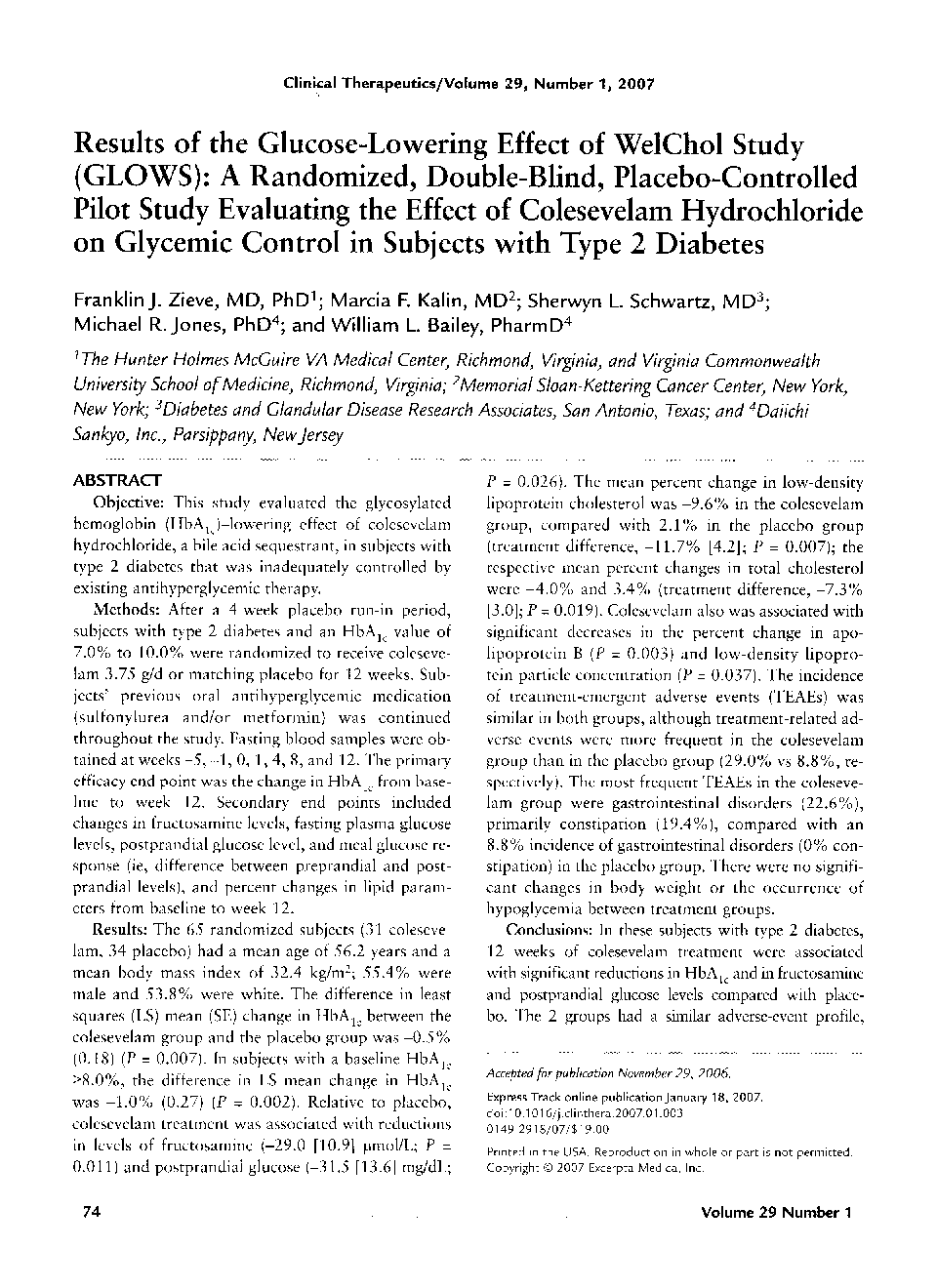| کد مقاله | کد نشریه | سال انتشار | مقاله انگلیسی | نسخه تمام متن |
|---|---|---|---|---|
| 2528844 | 1119989 | 2007 | 10 صفحه PDF | دانلود رایگان |

Objective:This study evaluated the glycosylated hemoglobin (HbA1c-lowering effect of colesevelam hydrochloride, a bile acid sequestrant, in subjects with type 2 diabetes that was inadequately controlled by existing antihyperglycemic therapy.Methods:After a 4-week placebo run-in period, subjects with type 2 diabetes and an HbA1c value of 7.0% to 10.0% were randomized to receive colesevelam 3.75 g/d or matching placebo for 12 weeks. Subjects' previous oral anti hyperglycemic medication (sulfonylurea and/or metformin) was continued throughout the study. Fasting blood samples were obtained at weeks −5, −1, 0, 1, 4, 8, and 12. The primary efficacy end point was the change in HbA1c from baseline to week 12. Secondary end points included changes in fructosamine levels, fasting plasma glucose levels, postprandial glucose level, and meal glucose response (ie, difference between preprandial and postprandial levels), and percent changes in lipid parameters from baseline to week 12.Results:The 65 randomized subjects (31 colesevelam, 34 placebo) had a mean age of 56.2 years and a mean body mass index of 32.4 kg/m2; 55.4% were male and 53.8% were white. The difference in least squares (LS) mean (SE) change in HbA1c between the colesevelam group and the placebo group was −0.5% (0.18) (P = 0.007). In subjects with a baseline HbAIc ≥ 8.0%, the difference in LS mean change in HbA1c was −1.0% (0.27) (P = 0.002). Relative to placebo, colesevelam treatment was associated with reductions in levels of fructosamine (−29.0 [10.9] pmol/L; P = 0.011) and postprandial glucose (−31.5 [13.6] mg/dL; P = 0.026). The mean percent change in low-density lipoprotein cholesterol was -9.6% in the colesevelam group, compared with 2.1% in the placebo group (treatment difference, −11.7% [4.2]; P = 0.007); the respective mean percent changes in total cholesterol were −4.0% and 3.4% (treatment difference, −7.3% [3.0]; P = 0.019). Colesevelam also was associated with significant decreases in the percent change in apolipoprotein B (P = 0.003) and low-density lipoprotein particle concentration (P = 0.037). The incidence of treatment-emergent adverse events (TEAEs) was similar in both groups, although treatment-related adverse events were more frequent in the colesevelam group than in the placebo group (29.0% vs 8.8%, respectively). The most frequent TEAEs in the colesevelam group were gastrointestinal disorders (22.6%), primarily constipation (19.4%), compared with an 8.8% incidence of gastrointestinal disorders (0% constipation) in the placebo group. There were no significant changes in body weight or the occurrence of hypoglycemia between treatment groups.Conclusions:In these subjects with type 2 diabetes, 12 weeks of colesevelam treatment were associated with significant reductions in HbA1c and in fructosamine and postprandial glucose levels compared with placebo. The 2 groups had a similar adverse-event profile, with the exception of an increased incidence of constipation in the colesevelam group. These results suggest that colesevelam may improve both lipid control and glycemic control in patients with type 2 diabetes receiving oral antihyperglycemic medications.
Journal: Clinical Therapeutics - Volume 29, Issue 1, January 2007, Pages 74-83